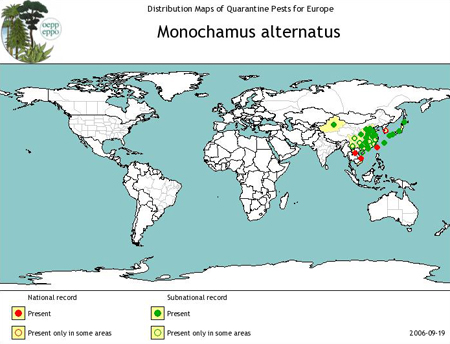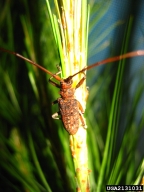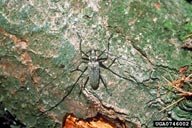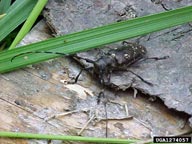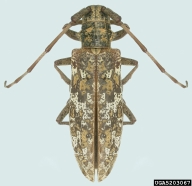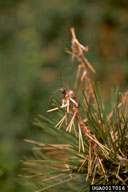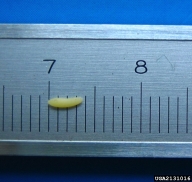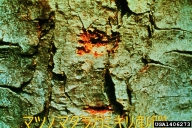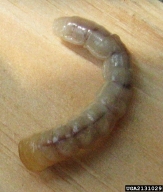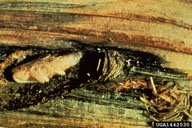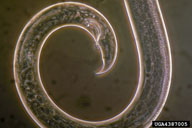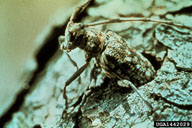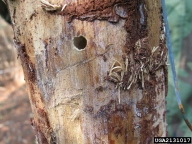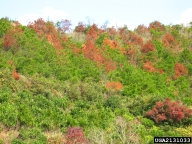Japanese pine sawyer
Monochamus alternatus Hope (Coleoptera: Cerambycidae)
Orientation to pest
Japanese pine sawyer, Monochamus alternatus Hope, is native to Asia, principally China, Japan and Korea. In Asia, this species has proven to be an important vector of an introduced pathogenic nematode, the pine wood nematode, Bursaphelenchus xylophilus (Steiner and Buhrer) Nickle, which kills Asian pines. Japanese pine sawyer is not yet present in the United States. Japanese pine sawyers overwinter as large larvae in galleries in infested trees. Pupation occurs at the end of winter, and adults emerge in spring and feed on foliage of hosts (termed maturation feeding). This feeding occurs on two-year old shoots of healthy trees. This feeding is important because it provides locations for nematode invasion of live healthy trees. Nematode larvae emerge from beetle spiracles, fall onto damaged twigs, and penetrate the woody tissue through the feeding wounds. Once mature, adult beetles laid their eggs in trees that are stressed or have recently been killed by bark beetles, lightening, disease or other factors. Eggs are placed singly in slots in bark cut by females. Each female may lay 100-200 eggs. Young larvae feed in the cambium and mature larvae tunnel into the heartwood to complete the cycle. There is one generation per year. Infestations damage wood of recently dead and downed conifers, causing degradation and loss of value for lumber.
The consequences of a potential introduction of Japanese pine sawyer to the United States by itself may not have severe consequences for two reasons. First, there are a number of other species of conifer-infesting Monochamus beetles already present in North America (e.g. M. caroliniensis, M. marmorator Kirby in Richardson, M. notatus Drury, M. titillator Fabricius, M. scutellatus say), all of which attack recently killed or severely stressed trees. If introduced and established in North America, Japanese pine sawyer would likely compete with these species for the same set of hosts. Secondly, the pine wood nematode, B. xylophilus, which is native to North America and is vectored by native Monochamus, does not kill North American conifers. However, an invasion of Japanese pine sawyer might also introduce an Asian species of Bursaphelenchus, such as Bursaphelenchus mucronatus (Mamiya and Enda) or Bursaphelenchus kolymensis Korentchenko, occur in Asia on species of Abies, Larix and Pinus (the former species has been found in Canada). These are not known to cause widespread mortality of their native hosts, but may be more pathogenic to some North American conifers, due to lack of evolutionary association and hence lack of selection for resistance. Such an effect is predicted by the damage caused to Asia conifers by an introduced American species of Bursaphelenchus. Detection of invasion must be based on collection and identification of adult beetles, as symptoms of infestation by M. alternatus are identical to those caused by native North American Monochamus species.
Hosts commonly attacked
Japanese pine sawyer is known to attack seventeen species of pines (Pinus), including, in Japan, Japanese red pine (Pinus densiflora Siebold and Zucc.), Japanese black pine (Pinus thunbergii Parl.), luchu pine (Pinus luchuensis Mayr), and, in China, Mason pine (Pinus massoniana Lambert). It has also been reported to attack three species of spruce (Picea spp.), and one species each of fir (Abies); true cedar (Cedrus), and larch (Larix). Under laboratory conditions, fresh logs of the North American slash pine (Pinus elliottii Engelmann) were preferred over the native Japanese P. densiflora for oviposition, but larval survival was lower.
Distribution
Japanese pine sawyer is native to Asia and is found mainly in Japan, China, Korea.
| Figure 1. World distribution of Japanese pine sawyer |
Images of Japanese pine sawyer
| Figure 2. Adult of Japanese pine sawyer, Monochamus alternatus, also showing adult feeding on needles | Figure 3. Various North American species are similar in appearance and biology to Japanese pine sawyer. For example: Monochamus notatus (left), Monochamus scuttelatus (Say) (middle), Monochamus marmorator Kirby (right) | ||
| Figure 4. Adults of Japanese pine sawyer feed on foliage after emergence to obtain food to develop eggs | Figure 5. Eggs of Japanese pine sawyer (left) and bark chewing (right) at oviposition site | Figure 6. Larva of Japanese pine sawyer | |
| Figure 7. Pupa of Japanese pine sawyer in the pupal chamber. The pupa is the stage that attracts the pine wood nematode, which trachea system of the pupa. | Figure 8. Tale of male pine wood nematode, Bursaphelenchus xylophilus, showing characteristic spicule |
| Figure 9. Exit hole of Japanese pine sawyer (left) and adult exiting hole (right) | Figure 10. Mason pine (Pinus massoniana) in China killed by Japanese pine sawyer |
Important biological control agents related to this pest species
In China, a recently recognized predator affecting Japanese pine sawyer is the Cryptalaus berus (Coleoptera: Elateridae) and in Japan, the predator, Dastarcus helophoroides (Fairmaire), is believed to be an important source of mortality.
Web links for information on Japanese pine sawyer
Articles
- Kobayashi, F.; A. Yamane, T. Ikeda. 1984. The Japanese pine sawyer beetle as the vector of pinewood nematode disease. Annual Review of Entomology 29:115-135.
- Mota, M. M. and P. Vieira (eds.). 2008. Pine Wilt Disease: a Worldwide Threat to Forest Ecosystems. Springer, New York.
